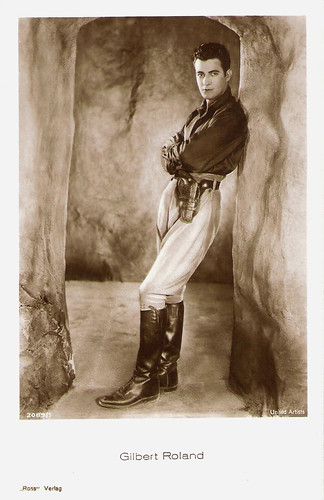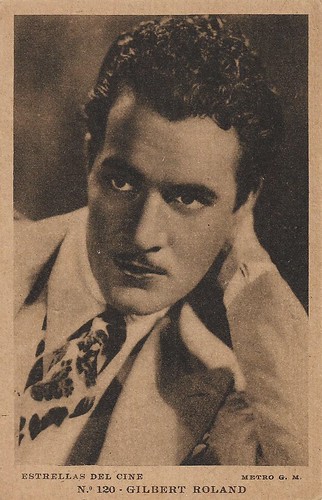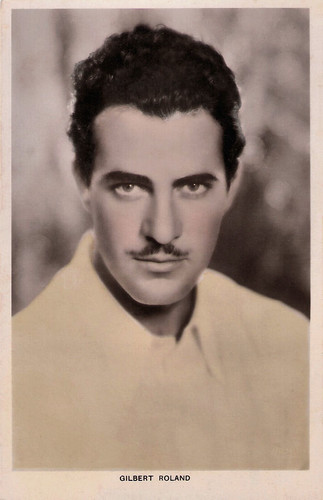
German postcard by Ross Verlag, no. 2089/1, 1927-1928. Photo: United Artists.

German postcard by Ross Verlag, no. 3407/1, 1928-1929. Photo: Defina / First National. Gilbert Roland and Mary Astor in Rose of the Golden West (George Fitzmaurice, 1927).

German postcard by Ross Verlag, no. 3670/1, 1928-1929. Photo: United Artists.

Austrian postcard by Iris-Verlag, no. 5161. Photo: United Artists.
Half macho half romantic ways and a handsome virile figure
Gilbert Roland was born Luis Antonio Damaso de Alonso in Ciudad Juárez, Chihuahua, Mexico, in 1905. He originally intended to become a bullfighter like his father and his paternal grandfather.
When Pancho Villa took control of their town, Roland and his family fled to the United States and lived in Texas. At age 14 he hopped on a freight train and went to Hollywood. After arriving there, he found menial jobs and slept in a Catholic church.
He often lost those jobs because he spent time working as an extra in films. He chose his screen name by combining the names of his favourite actors, John Gilbert, and Ruth Roland. His Mexican roots, his half macho half romantic ways, his handsome virile figure helped him land roles, often stereotypical Latin lover roles.
Roland's first film contract was with Paramount. His first major role was in the collegiate comedy The Plastic Age (Wesley Ruggles, 1925) together with Clara Bow, to whom he became engaged. The film became a major hit in late 1925 and was Bow's first hit film. She became a star as a result of its success, which led her to be signed by a major studio and becoming a major star with the 1927 release of It.
In 1926, Roland played Armand Duval opposite Norma Talmadge as Marguerite Gautier in Camille (Fred Niblo, 1926), based on the play adaptation of 'La Dame aux Camélias' (The Lady of the Camellias) by Alexandre Dumas, fils. Roland and Talmadge were romantically involved, and they starred together in several productions. The love affair resulted in Talmadge's divorce from Joe Schenck.
With the advent of sound films, Roland frequently appeared in romantic lead roles in Spanish language adaptations of American films. An example is Resurrección/Resurrection (1931), a Spanish-language adaptation of Leo Tolstoy's 1899 novel 'Resurrection', produced by Universal Studios. The same year, they made the first English-language all-talking version of the film. The film was directed by Eduardo Arozamena and David Selman and starred Gilbert Roland and Lupe Vélez, who also starred in the English-language version.

Swedish postcard by Förlag Nordisk Konst, Stockholm, no. 1374.

French postcard by J.R.P.R., Paris, no. 60. Photo: First National. Gilbert Roland and Norma Talmadge in Camille (Fred Niblo, 1926).

German postcard by Ross Verlag Foreign, no. 3671/1, 1928-1929. Photo: United Artists. Gilbert Roland and Norma Talmadge in The Woman Disputed (Henry King, Sam Taylor, 1928).

German postcard by Ross Verlag, no. 5364/1, 1930-1931. Sold in Italy exclusively by Editrice Ballerini & Fratini, Firenze (125). Photo: M.G.M.

Spanish postcard in the Estrellas del cine series by Editorial Grafica, Barcelona, no. 120. Photo: Metro-Goldwyn-Mayer.
Critics began to take notice of his acting
In 1933, Gilbert Roland played a large supporting role in She Done Him Wrong as one of Mae West's character's lovers, along with rivals Cary Grant, Noah Beery Sr. and Owen Moore. He appeared with his future wife Constance Bennett as Pepe in Our Betters (George Cukor, 1933), and in the same year, as the romantic lead in After Tonight (George Archainbaud, 1933), a World War I drama.
During World War II, Roland served in the United States Army Air Corps. In the mid-1940s, he appeared in a series of films as the popular character The Cisco Kid.
Beginning in the 1940s, critics began to take notice of his acting and he was praised for his supporting roles in We Were Strangers (John Huston, 1949), The Bad and the Beautiful (Vincente Minnelli, 1952), Thunder Bay (Anthony Mann, 1953), and Cheyenne Autumn (John Ford, 1964).
He played Hugo, the agnostic (and fictional) friend of the three shepherd children in The Miracle of Our Lady of Fatima (John Brahm, 1952), based on the apparitions of Our Lady of Fatima in Portugal in 1917. In 1953, Roland played Greek-American sponge diver Mike Petrakis in the epic Beneath the 12-Mile Reef (Robert D. Webb, 1953) starring Robert Wagner.
On television, Roland played guest roles in such Western series as Death Valley Days (1963), Gunsmoke (1963), and Bonanza (1965). He also appeared in episodes of Kung Fu (1973), and Hart to Hart (1980). He both wrote the script for and acted in an episode of Wagon Train (1958).
In Europe, he played a sinister character in such Spaghetti Westerns as in Vado... l'ammazzo e torno/Today It's Me... Tomorrow It's You (Enzo G. Castellari, 1967) starring Edd Byrnes and Ognuno per sé/The Ruthless Four (Giorgio Capitani, 1968) with Van Heflin and Klaus Kinski. His last film appearance was in the Western Barbarosa (Fred Schepisi, 1982) starring Willie Nelson.
Gilbert Roland married actress Constance Bennett in 1941 in Yuma, Arizona. They were married until 1946 and had two daughters, Lorinda 'Lynd' (1938) and Christina 'Gyl' (1941). Bennett won custody of their daughters. His second marriage to Guillermina Cantú in 1954 lasted until his death 40 years later.
Gilbert Roland died of cancer in Beverly Hills, California in 1994, aged 88. His body was cremated and his ashes scattered at sea. Roland was nominated twice for a Golden Globe Award, for his roles in The Bad and the Beautiful (1952) and Cheyenne Autumn (1964). For his contributions to the motion picture industry, Gilbert Roland has a star on the Hollywood Walk of Fame at 6730 Hollywood Boulevard.

French postcard by Europa, no. 287. Photo: Regal Film.

French postcard by Europe, no. 1374. Photo: Regal Film / United Artists Corp. N.Y.

British handcoloured postcard in the Colourgraph Series, London, no. C 58.

Dutch postcard by De Faam, Breda. Photo: Metro-Goldwyn-Mayer.

British postcard in The Picturegoer Series, London, no. D 270. Photo: Warner Bros.
Sources: Guy Bellinger (IMDb), Wikipedia, and IMDb.
This post was last updated on 12 June 2021.
Absolutely one of my favorites. Loved him in Barbarosa.
ReplyDelete